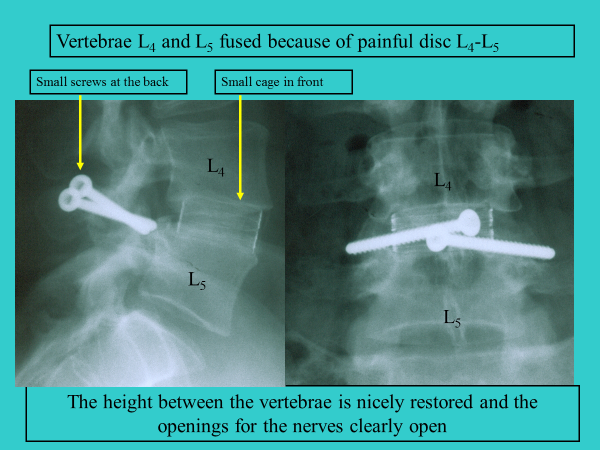The wear and tear of the discs can lead to the following:
- Low Back Pain for the discs in the low back, and Neck Pain for the discs in the cervical spine
- Radiating pain or numbness down the legs (for the low back) and down the arms (for the neck)
Let us discuss the problems of pain and radiating pain separately. We will first explain the dull ache, which becomes progressively more intense over the months and years, and then we will analyze the sudden acute pain in the low back or neck which makes all movement near to impossible and which can radiate down the limbs.
Dull LOW BACK PAIN due to wear and tear of the discs
‘Doctor, I want them to get off my back’
In the beginning, the treatment is best followed by the general practitioner. On the menu, you will find: medication, a diet, cease smoking, exercises for back and abdominal muscles, osteopathy, physiotherapy, acupuncture, a lumbar belt, improvement of work surroundings, a better bed etc. One thing is certain: BEDREST DOES NOT HELP AND IS HARMFUL
If all this does not help, one could wonder ‘CAN AN OPERATION BRING IMPROVEMENT?’
In some cases, yes. The principle consists of removing the worn out disc and fixing the adjoining vertebrae to one another (arthrodesis or spondylodesis). Alternatively, a mobile artificial disc can be inserted. Unfortunately, these operations have their limitations. Indeed, only a few discs may be affected. Best are one, two or three levels. To operate more levels is technically quite possible, but the results are not as good. The current state of the art techniques allow us to say that the odds that someone would feel significantly better at, let’s say one year after surgery, are around 80%. This does not mean that a specific person will be 80% improved, but that out of a hundred operated people, 80 are satisfied and 20 disappointed. That does not mean they are worse off, but that, of course, is a subjective experience. Any specialist claiming a higher success rate is in fact not honest. The decision to have such an operation done does not lie with the back pain specialist, but with the patient her/himself. The patient therefore also carries the responsibility linked to this decision. Indeed, back and/or neck pain are not life-threatening conditions and an operation is never ‘absolutely’ unavoidable as it can be the case in the presence of a malign tumour. The role of the back specialist is one of explaining what is happening and why and what the alternative treatment modalities are, each with their advantages and disadvantages. Once the patient understands the situation clearly she/he can make an informed decision. From that moment onwards, the surgeon will be totally dedicated to the case ensuring an excellent operation and a good postoperative follow-up.
The operative technique used for these interventions may vary from case to case and are best explained by the surgeon for each individual patient. The operations are performed under general anaesthesia, are not really painful, and the hospital stay is only a few days. Patients walk home from the hospital and active revalidation is seldom required.
The hospitals dispose of the most modern infrastructure with computer guided surgery and microscopes. The use of one or other instrument is evaluated for each case individually and discussed with the patient.
